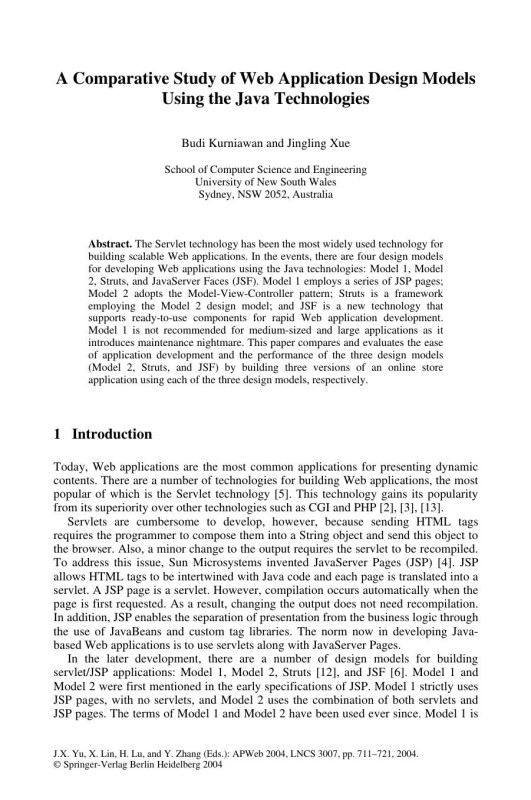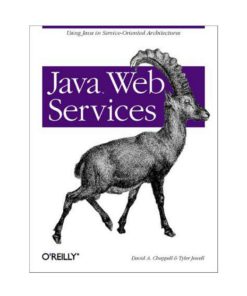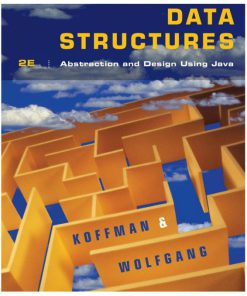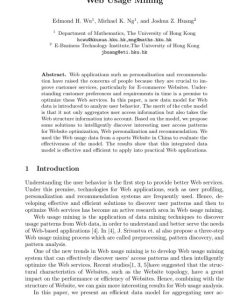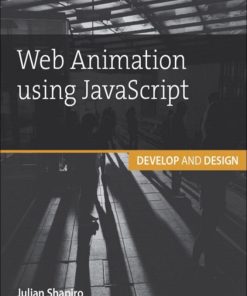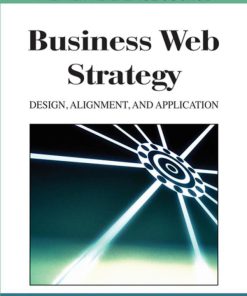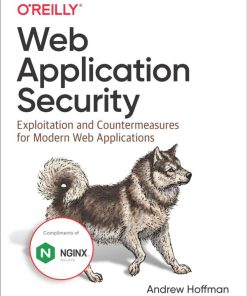A Comparative Study of Web Application Design Models Using the Java Technologies 1st edition by Budi Kurniawan, Jingling Xue ISBN 3540213710 978-3540213710
$50.00 Original price was: $50.00.$25.00Current price is: $25.00.
Authors:Budi Kurniawan; Jingling Xue , Tags:Advanced Web Technologies and Applications , Author sort:Kurniawan, Budi & Xue, Jingling , Languages:Languages:eng , Published:Published:Feb 2004
A Comparative Study of Web Application Design Models Using the Java Technologies 1st edition by Budi Kurniawan, Jingling Xue – Ebook PDF Instant Download/Delivery. 3540213710, 978-3540213710
Full download A Comparative Study of Web Application Design Models Using the Java Technologies 1st Edition after payment
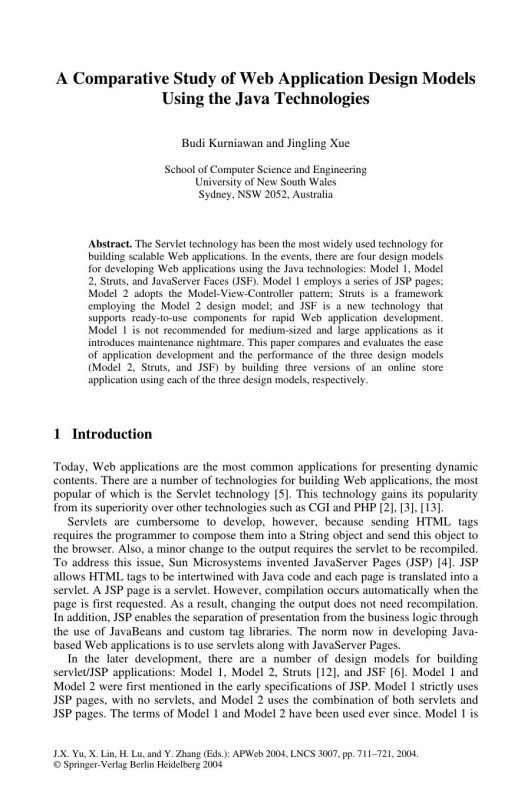
Product details:
ISBN 10: 3540213710
ISBN 13: 978-3540213710
Author: Budi Kurniawan, Jingling Xue
The Servlet technology has been the most widely used technology for building scalable Web applications. In the events, there are four design models for developing Web applications using the Java technologies: Model 1, Model 2, Struts, and JavaServer Faces (JSF). Model 1 employs a series of JSP pages; Model 2 adopts the Model-View-Controller pattern; Struts is a framework employing the Model 2 design model; and JSF is a new technology that supports ready-to-use components for rapid Web application development. Model 1 is not recommended for medium-sized and large applications as it introduces maintenance nightmare. This paper compares and evaluates the ease of application development and the performance of the three design models (Model 2, Struts, and JSF) by building three versions of an online store application using each of the three design models, respectively.
A Comparative Study of Web Application Design Models Using the Java Technologies 1st Table of contents:
-
Introduction
- 1.1 Overview of Web Application Development
- 1.2 Importance of Java Technologies in Web Application Design
- 1.3 Objectives of the Comparative Study
- 1.4 Scope and Structure of the Paper
-
Background and Java Technologies for Web Development
- 2.1 Evolution of Java in Web Development
- 2.2 Key Java Technologies for Web Applications: JSP, Servlets, EJB, and Spring
- 2.3 Java EE (Enterprise Edition) and Its Role in Web Application Design
- 2.4 Comparison of Java with Other Web Development Technologies
- 2.5 Tools and Frameworks in the Java Ecosystem for Web Development
-
Web Application Design Models
- 3.1 Overview of Web Application Architecture
- 3.2 Traditional Monolithic Architecture
- 3.3 Client-Server Architecture
- 3.4 Microservices Architecture
- 3.5 MVC (Model-View-Controller) Design Pattern
- 3.6 Event-Driven and Reactive Architectures
- 3.7 Comparison of Web Application Architectures
-
Java Web Frameworks
- 4.1 Java Server Pages (JSP) and Servlets
- 4.2 Enterprise JavaBeans (EJB)
- 4.3 Spring Framework: Spring MVC, Spring Boot, and Spring Cloud
- 4.4 JavaServer Faces (JSF)
- 4.5 Play Framework and Other Non-Java-based Frameworks
- 4.6 Comparison of Java Web Frameworks Based on Features, Scalability, and Usability
-
Design Model 1: JSP and Servlets
- 5.1 Architecture and Design Principles of JSP and Servlets
- 5.2 Advantages and Disadvantages of JSP and Servlets
- 5.3 Typical Use Cases for JSP and Servlets
- 5.4 Performance and Scalability Considerations
- 5.5 Example Web Application Using JSP and Servlets
-
Design Model 2: Spring Framework
- 6.1 Overview of Spring Framework for Web Application Development
- 6.2 Architecture and Core Components: Spring MVC, Spring Boot, and Spring Security
- 6.3 Advantages of Using Spring for Web Development
- 6.4 Disadvantages and Challenges of Spring Framework
- 6.5 Performance, Security, and Scalability in Spring-Based Applications
- 6.6 Example Web Application Using Spring Framework
-
Design Model 3: JavaServer Faces (JSF)
- 7.1 Introduction to JSF for Web Application Development
- 7.2 JSF Architecture: Managed Beans, Facelets, and Navigation Rules
- 7.3 Benefits and Limitations of Using JSF
- 7.4 Performance and Integration Challenges in JSF
- 7.5 Example Web Application Using JSF
-
Design Model 4: Enterprise JavaBeans (EJB)
- 8.1 Role of EJB in Java Web Application Architecture
- 8.2 Types of EJB: Stateless, Stateful, and Singleton
- 8.3 Benefits and Drawbacks of Using EJB
- 8.4 Performance Considerations in EJB-Based Applications
- 8.5 Example Web Application Using EJB
-
Design Model 5: Microservices Architecture Using Java
- 9.1 Microservices Architecture: Principles and Benefits
- 9.2 Implementing Microservices in Java Using Spring Boot and Spring Cloud
- 9.3 Advantages and Challenges of Microservices in Web Application Design
- 9.4 Performance, Scalability, and Fault Tolerance in Microservices
- 9.5 Example Web Application Using Microservices Architecture
-
Comparative Analysis of the Java Web Application Design Models
- 10.1 Comparison Criteria: Performance, Scalability, Security, and Maintainability
- 10.2 Evaluation of JSP/Servlets, Spring, JSF, EJB, and Microservices Models
- 10.3 Suitability of Each Model for Different Web Application Types
- 10.4 Strengths and Weaknesses of Each Design Model
- 10.5 Cost, Development Time, and Resource Considerations
-
Best Practices and Recommendations
- 11.1 Choosing the Right Design Model Based on Project Requirements
- 11.2 Guidelines for Improving Performance and Scalability
- 11.3 Security Best Practices in Java Web Applications
- 11.4 Enhancing Maintainability and Extensibility
- 11.5 Future Trends in Java Web Application Design
-
Challenges and Open Issues
- 12.1 Handling Complexity in Large-Scale Web Applications
- 12.2 Managing Integration and Interoperability Between Different Java Technologies
- 12.3 Evolving Java Technologies and Their Impact on Web Application Design
- 12.4 Addressing Development and Maintenance Challenges
-
Conclusion
- 13.1 Summary of Findings from the Comparative Study
- 13.2 Final Thoughts on Java Web Application Design Models
- 13.3 Future Research Directions in Java-Based Web Application Architectures
- 13.4 Concluding Remarks on Selecting the Optimal Design Model
People also search for A Comparative Study of Web Application Design Models Using the Java Technologies 1st:
what is the study of comparative literature
a comparative study of various approaches to adaptive web scraping
a comparative study of automation testing tools for web applications
comparative web traffic statistic crossword
journal of comparative politics

